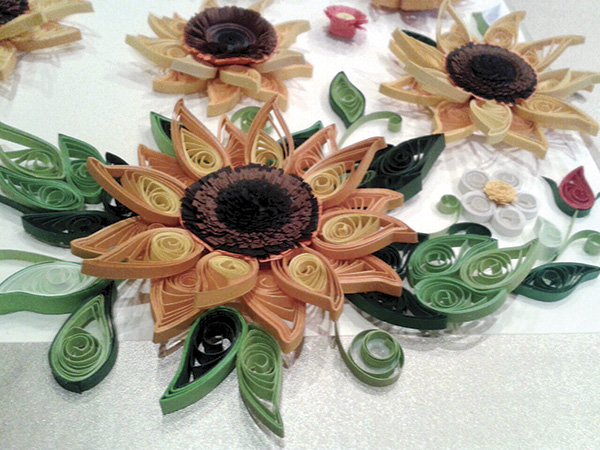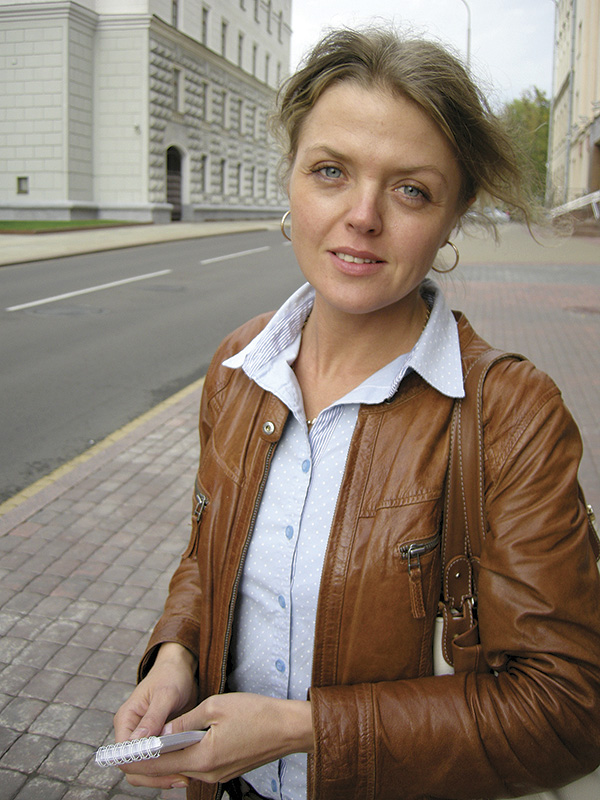Quilling is the art of making flat or three-dimensional compositions from rolled paper strips, long and narrow. Lyudmila Bulova-Zhdanovich tells us that some call it paper filigree. Spirals are made in various forms, and then composed into postcards, pictures, photo-frames and many other things. Early on, the spirals were wound around the quills of bird feathers.

‘Sunflowers.’ Fragment of the panel picture
Lyudmila’s husband, Timofei, gave her entry to a master class as a gift on their 7th wedding anniversary, in 2012. The event was held in a shop in Nemiga Street, with five people taking part. “We were shown how to make a postcard in under an hour,” she recollects. It only involved a flower, couple of leaves and a butterfly but I’ve kept it as a reminder of how I began quilling.”
Quilling has been a pastime since the late 14th century, in Mediterranean Europe, invented by monks, using paper from the gilded edges of books, to simulate golden miniatures in poor churches. The art gradually spread all over the world, and became especially widespread in Germany and in Great Britain. The technique is simple, but requires patience, assiduity, dexterity and accuracy, as well as rich imagination.
By the 19th century, such paper filigree work was considered to be a woman’s hobby rather than a true art form, and fell out of favour. However, it returned to popularity about two decades ago. Admired by Queen Elizabeth II, her own creations are on show at the famous Victoria and Albert Museum in London.
Lyudmila asserts that it’s good to use your imagination, using not just paper but feathers, dried flowers, pinecones and herbs, and beads. She comments, “Having made dozens of works, I know that making pictures is of most interest to me. I’ve perfected the technique on postcards, and have acquired quilling-dexterity. Now, I make still life compositions and receive orders. It’s been almost two years since I became a craftswoman, registered for income tax. Annually, I pay the equivalent of one basic salary in tax [Br210,000 or about $10]. As to what I can create, you can view my page on the Odnoklassniki social network. Word of mouth also works. People who’ve seen my postcards want to buy them for themselves or for friends. I make invitations for weddings, and birthday cards and souvenirs. Sometimes, customers choose their own colours. In honesty, making these isn’t too interesting. I’d rather make original works. Sometimes, I become enthusiastic about an idea and it’s so exciting. It’s as if I’m cultivating something inside me, which makes me proud.”
Lyudmila began spending more time quilling while at home with her small son, Boriska. In 2013, after returning to work (as an advanced manufacturing engineer at the Publishing Centre of the Belarusian State University) she began making postcards in the evenings. “I loved it!” she admits.
Her daughter, Dasha, has been inspired to try her hand too, although she’s yet to grasp finer motor skills. Quilling is great for adults and for children. “Imagine my happiness when, for my 35th birthday, I received a card from my children, made with the help of the grandfather, Piotr. We were visiting him in our home village of Pogoreloye, in Osipovichi District, in the summer. They’d worked hard to study my techniques. It was the first such card I’d received, and I keep it still,” smiles Lyudmila.

Lyudmila also recollects a summer trip to see grandmother Olya and grandfather Ivan, in the village of Yatskovschina, in Lyakhovichi District of Brest Region. The elderly couple had a pile of postcards, alongside photos, and let Lyudmila cut the cards up to create appliqués, vases and caskets. “As far as I remember, I always wanted to create something beautiful. Once, online, I found an article about old postcards and their value. Some I recognized from my childhood, from Yatskovcshina! I’d collected postcards myself and Timofei knew that handicrafts had always interested me, which inspired his master class gift. People say that I’m talented and perhaps it’s true. It may be a divine gift to help me emotionally. It’s more than entertainment; it gives me strength.”
Our ancestor Belarusians knew about the ‘curative’ effect of handicrafts. In her grandmother Olya’s house, she always admired the embroidered, self-woven tablecloth and the embroidered napkins placed on the icons. “I still have a tablecloth from Yatskovschina,” says Lyudmila. “I remember self-woven blankets, which covered my grandmother’s bed and my own, showing beautiful turkeys and roses. My grandmother also wove doormats and narrow rugs for the floor. She loved embroidery, always having some on the go in her bag, with embroidery threads.”
Lyudochka’s grandmother never spoke of the therapeutic aspect of needlework but, after many years, Luda has grasped this for herself. She explains that you need to let your thoughts drift, not focusing on any particular problem. Then, you find tranquillity and consolation. The problem remains but you feel better able to deal with it. “It’s not for nothing that women always used to embroider, even those who were gentrified. When you make something by hand, your head comes into order and becomes clear. It’s wonderful to see chaos become harmony. Perhaps, this harmony heals my soul. When your mind is in chaos, there can be no order in your life: in business, health, or relations with people. You feel restless, as your soul is in pain. You feel sorry for yourself. Through creative effort, chaos becomes beauty and happiness, as in fairy-tales, where the frog turns into a prince. People have known about the influence of needlework on the subconscious since olden times. When you need to ‘wind down’, needlework is the answer!”
She gains huge enjoyment from looking at her crafted achievements, telling us, “My soul becomes full of happiness! When I want to make something interesting, and have an idea, my fingers begin to move and I know straight away that something wonderful will be created. The anticipation is great. You design, sketch out, plan and then enter another plane of thought and feeling, creating a flower or a leaf. In creating a picture, you find yourself at peace. Quilling is a form of self-expression, revealing the soul. I also gain pleasure from seeing others’ pleasure.”
Some of her works have been given away and she has no photograph to remember them by; others she remembers to record. It usually takes two evenings to make a large composition, once the children are sleeping, working from 11pm until around 2am. Compositions of А3 size take longer, made especially for offices, anniversaries or birthdays. Lyudmila once made a three-dimensional vase with flowers.

‘Dozhynki’ composition
She is currently interested in national themes, making a ‘Dozhynki’ (a harvest festival) last year, and special images for Kupalie night, Christmas, and other national holidays. “My mother-in-law was a junior school teacher but is now retired and lives in Volozhin, where she has a house, living with her husband. His brother Ilya joins them every year for Christmas,” comments Lyudmila. “Irina Borisovna lays the table, puts hay under the tablecloth, and prepares seven traditional dishes. There’s an expectation of happiness, love and light: with the Christmas star, houses, snowflakes and hoar-frost patterns. All is dark-blue, shining with golden bells. On Christmas Eve, we go to the old wooden church, joining many others. I’d love to create a picture of the church.”
As to her secrets, Lyudmila answers, “Secrets are endless. My imagination has its secrets but, through quilling, I hope to unearth them. Each time I start a new piece of work, I say a prayer; when I finish, I thank God for his help and support.”
By Ivan Ivanov











